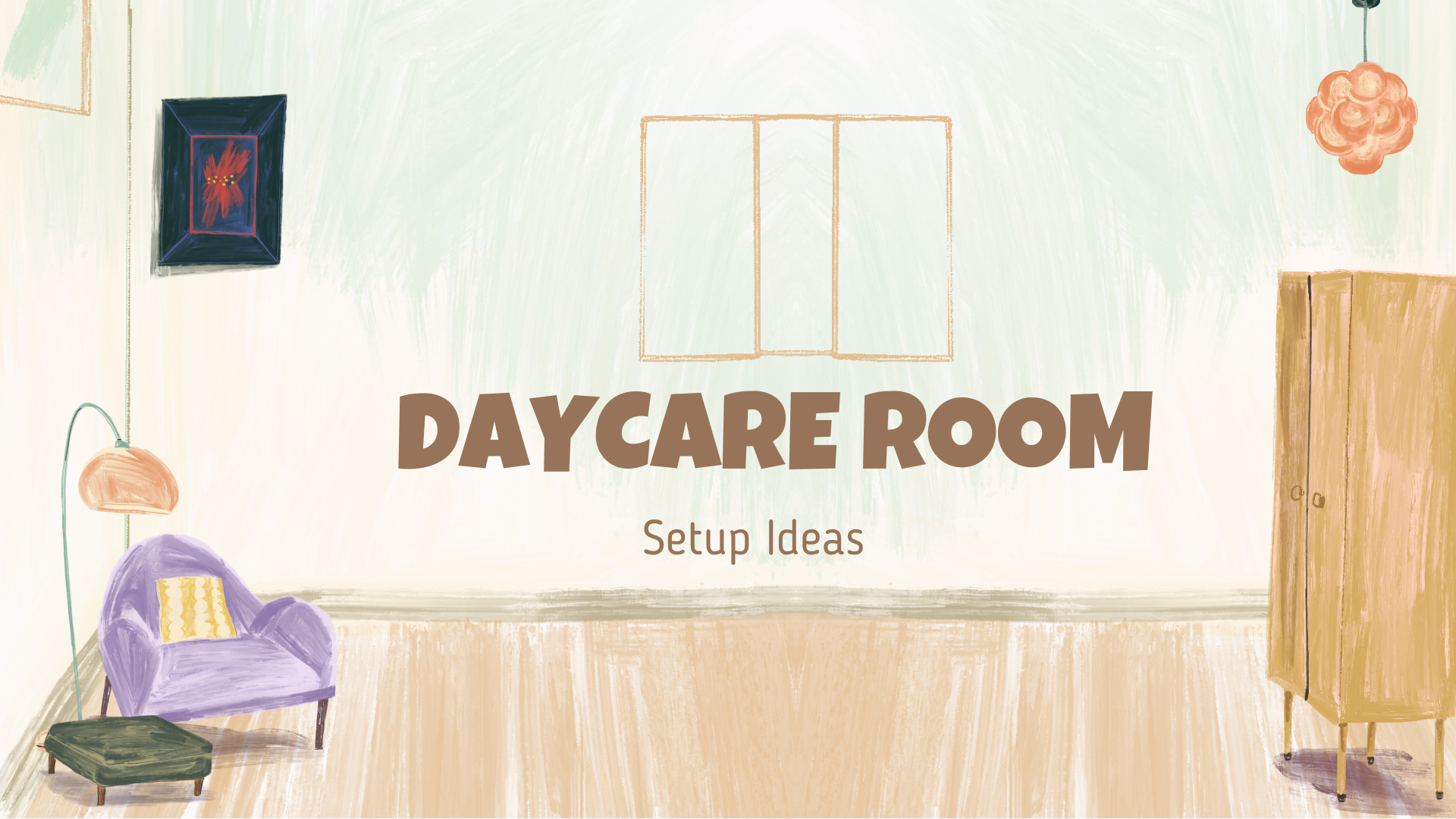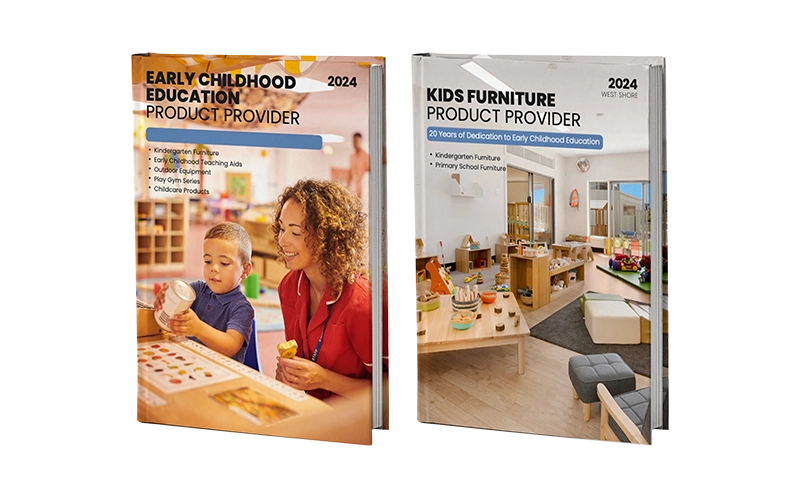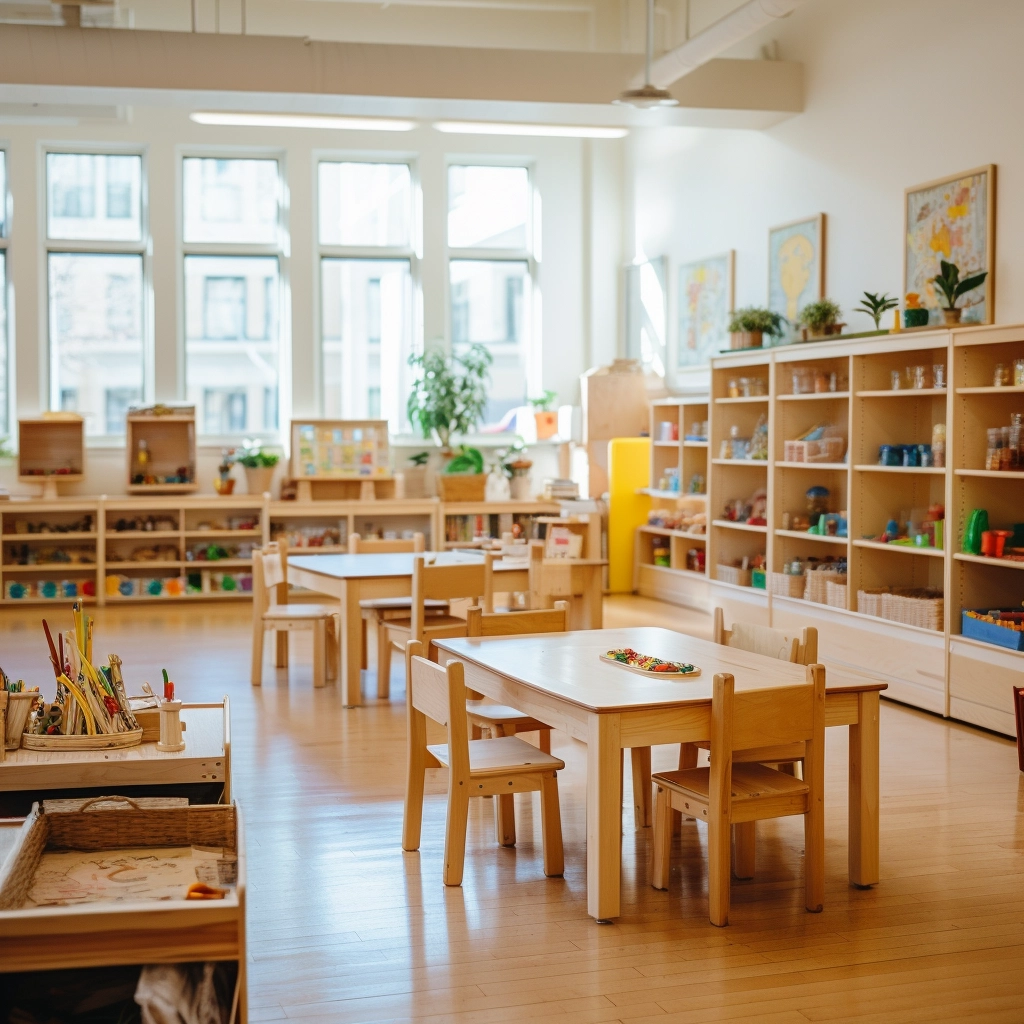Are you confused about how to set up your daycare room? Wondering what the best daycare room setup ideas are for arranging spaces that meet the needs of both infants and toddlers? How can you design a layout that feels safe yet stimulating? Most importantly, how do you ensure your daycare environment promotes learning, independence, and comfort for every child?
The truth is, daycare room setup ideas are crucial to daily routines and child development. A cluttered or poorly arranged space can cause stress, safety hazards, and disrupt children’s ability to focus. On the other hand, a well-thought-out daycare room setup can ease transitions, encourage exploration, and create a secure environment where children feel at home and ready to engage in new experiences.
In this article, we’ll explore practical daycare room setup ideas that help you create a safe, inviting, and well-organized environment for both infants and toddlers, fostering a place where they can grow, learn, and thrive.
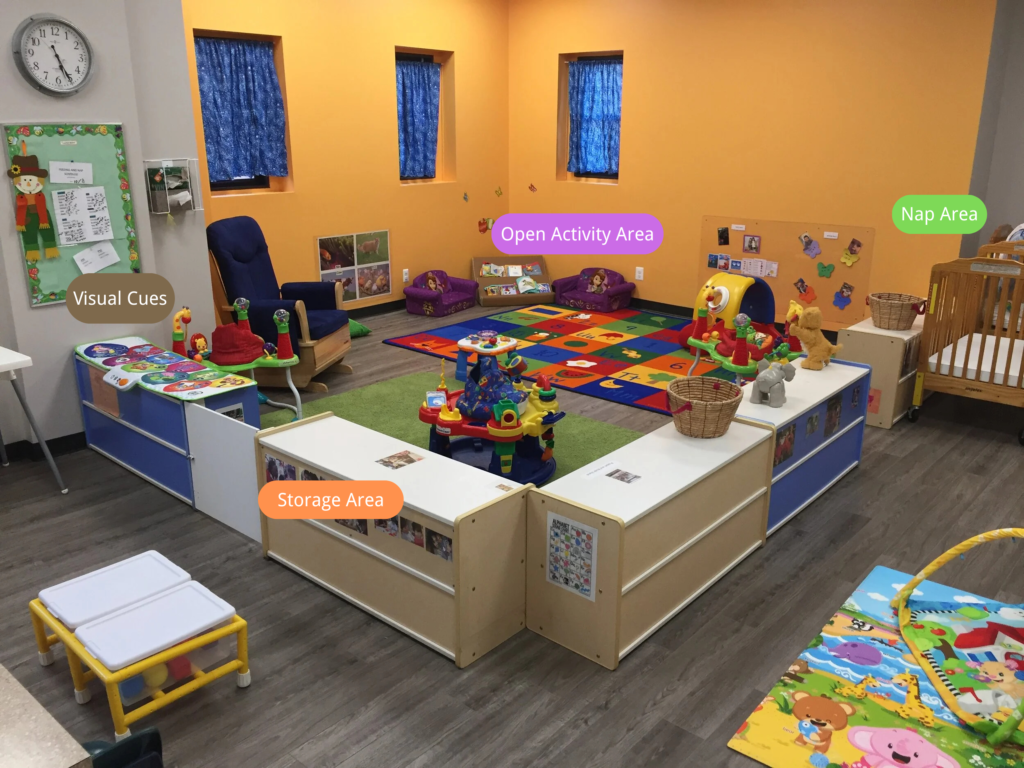
What to Keep in Mind Before Setting Up Your Daycare Room?
There’s no single, absolute standard for choosing daycare decor or a decorating scheme. When choosing a design, consider your child’s specific circumstances or individual factors. Overall, consider factors like the child’s age, the space available, and your educational philosophy. This article offers several daycare room ideas from various perspectives, but while you’re considering these ideas, you should also research the specific licensing requirements for childcare facilities in your area to ensure that your space meets all safety and regulatory standards.
Daycare Room Setup Ideas: Spaces or Zones
One of the key aspects of daycare room design is creating clear spaces or zones that cater to different activities. These zones help guide children’s behavior, support various developmental stages, and ensure that the room stays organized and easy to navigate. Well-planned spaces allow children to transition between activities smoothly while maintaining a sense of order and focus.
Designated Play Zones
Active play is essential for children’s physical development, and having a designated play zone encourages safe and structured exploration. This area can include soft play equipment, climbing structures, or large floor cushions where children can move freely. By defining a specific space for play, you help children understand boundaries while still allowing them to express their energy in a controlled way.
Learning Zones
Next, create learning zones where children can focus on specific tasks like reading, drawing, or building. These zones should be quieter and more structured than play areas, with child-sized desks, shelves of books, and activity tables. Organizing these spaces ensures that children can engage in both independent work and group activities without distractions from the play zones.
Sensory and Calm Zones
Young children can become easily overstimulated, so having a sensory or calm zone provides a retreat where they can self-regulate and unwind. This zone might include soft seating like beanbags or cushions, dim lighting, and calming visual elements such as soft mobiles or wall decals. Sensory bins with materials like rice or fabric can also encourage tactile exploration while promoting relaxation.
Social Interaction Zones
Preschoolers, toddlers, and even infants benefit from spaces that encourage socialization and teamwork. A social interaction zone is designed for group activities, whether it’s for building with blocks, group art projects, or role-playing in a dramatic play area. These zones help children develop critical social-emotional skills like cooperation, sharing, and conflict resolution.
Rest and Nap Zones
Every daycare room should include a designated area for rest and nap time. Rest zones should be quiet, free from distractions, and designed for comfort. Cribs for infants and nap mats for toddlers or preschoolers should be spaced adequately to follow safety regulations and ensure comfort. Soft, neutral colors, blackout shades, and white noise machines can help foster a restful environment conducive to napping.
Flexible Spaces for Multiple Uses
Daycare rooms often need to be adaptable to changing activities throughout the day. A flexible space can be a multi-purpose area, like an open floor section that transforms from a play zone to a learning zone or group activity space. Furniture that’s easy to move or reconfigure allows the room to serve different functions depending on the time of day or specific needs.
By thoughtfully creating defined spaces for play, learning, rest, and socialization, daycare rooms can become flexible, organized environments that cater to all aspects of children’s development. These spaces not only support the needs of children at different developmental stages but also make the room easier for caregivers to manage.
Infants’ Room Setup Ideas
Creating an infant classroom means building a space that’s calm, predictable, and easy to supervise. Babies spend their days cycling through sleep, feeding, and short bursts of awake play, so the daycare setup should support those rhythms while meeting health and safety standards for group care. Thoughtful daycare room ideas can make a world of difference, ensuring that both caregivers and babies have a smooth, safe, and nurturing environment.
Lighting and atmosphere
Natural light sets the tone for the day and can support healthy sleep patterns. If windows are limited, use warm, low‑glare lamps instead of harsh overhead bulbs. Keep colors soft and finishes matte to reduce visual noise.
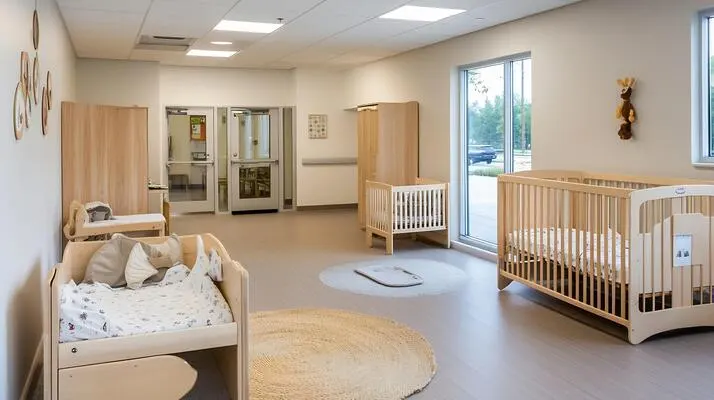
Crib and nap zone
Place cribs in a quiet corner with safe spacing per local licensing rules. Follow current AAP safe‑sleep guidance: firm mattress, snug fitted sheet, no loose bedding, bumpers, or stuffed toys. Use dimmable lights and blackout shades to help babies settle.
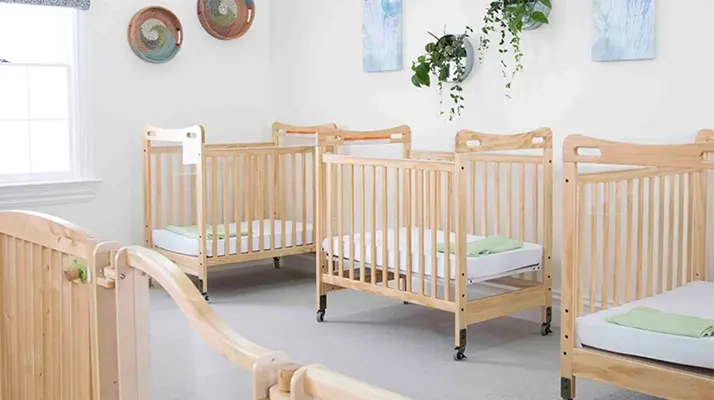
Soothing soundscape
A gentle layer of white noise or soft instrumental music can mask hallway sounds and support naps. Keep volumes low and consistent; silence alarms and toys in the sleep area.
Tummy time and early play
Create a low, cushioned area with a wipe‑clean mat and a small rotation of sensory items—crinkle cloths, soft mirrors, textured balls. Place items just within reach to encourage reaching, rolling, and head control.
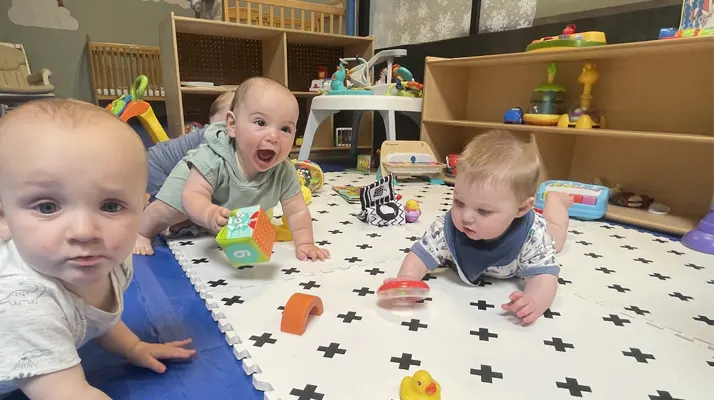
Feeding nook
Give caregivers supportive seating (rockers or floor chairs with back support) and a side table for bottles, burp cloths, and sanitizing supplies. If possible, position this area near a sink or sanitizer station to streamline hand hygiene.
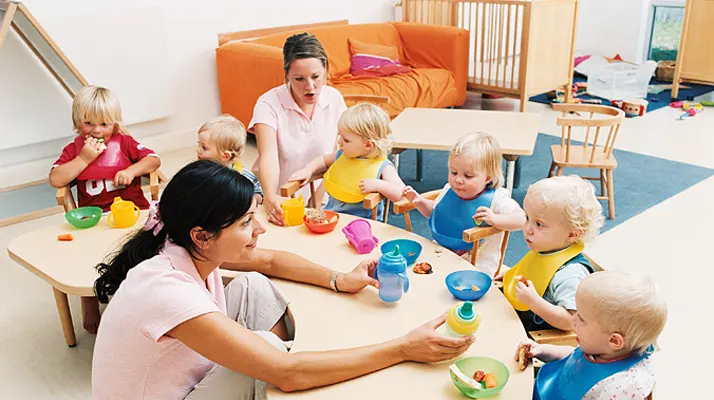
Diapering and sanitation
Set the changing table where you can maintain line‑of‑sight to the room. Stock diapers, wipes, gloves, and creams within arm’s reach; use a hands‑free trash can and keep a sink nearby. Choose wipeable, non‑porous surfaces throughout.

Decorative Rugs
A soft rug can define the play zone and cut down on noise. Choose low‑pile, non‑slip, easy‑to‑clean materials in gentle patterns.
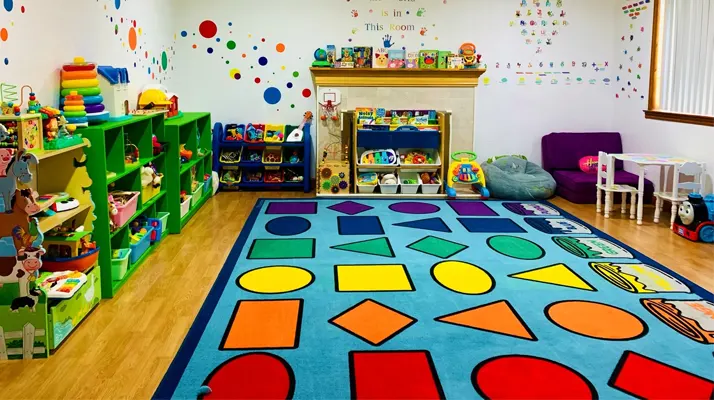
Compact Crib Option
Where regulations allow, mini cribs can increase capacity without crowding. Maintain required spacing and clear egress at all times.
Supervision and safety by design
Arrange furniture to keep clear sightlines from any primary care position. Anchor shelves, cap outlets, and choose only age‑rated, non‑toxic materials. Keep up with product recalls and select items that sanitize easily and dry quickly.
IL daycare room setup ideas you choose for infants play a key role in creating a comfortable and safe environment for babies to grow and thrive. By thoughtfully organizing sleep areas, play zones, and feeding spaces, you ensure that caregivers can provide the highest level of care while babies remain secure and supported. When you prioritize safety, comfort, and functionality in your infant room design, you’re creating the foundation for healthy early development and positive daily routines.
Toddlers’ Room Setup Ideas
Designing a toddler classroom requires balancing freedom of movement with safe boundaries. At this stage, children are eager to explore, test independence, and build social skills. The daycare room setup should encourage curiosity and physical activity, while also helping caregivers maintain order and visibility. Thoughtful daycare setup ideas ensure that toddlers have a space to grow, learn, and interact safely with their peers.
Active play zones
Toddlers thrive on movement, so dedicate a portion of the room to safe climbing structures, tunnels, or ride-on toys. Soft flooring reduces the risk of falls, and open space allows children to run, jump, and practice coordination without feeling restricted.
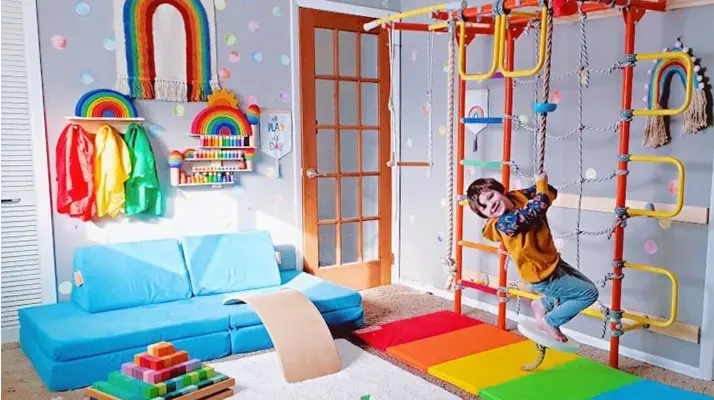
Learning centers
As toddlers begin experimenting with problem-solving, small learning stations can guide their curiosity. Puzzles, stacking blocks, and pretend-play areas like kitchens or tool benches give structure to play and gently introduce cooperative learning.
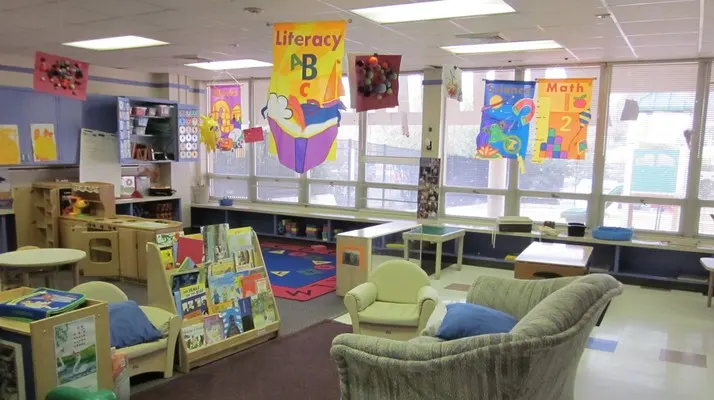
Reading and storytelling corner
A cozy nook with beanbags, child-sized chairs, and a shelf of sturdy board books provides a calm retreat. Position this area away from the active play zone to minimize distractions and encourage focus during story time.
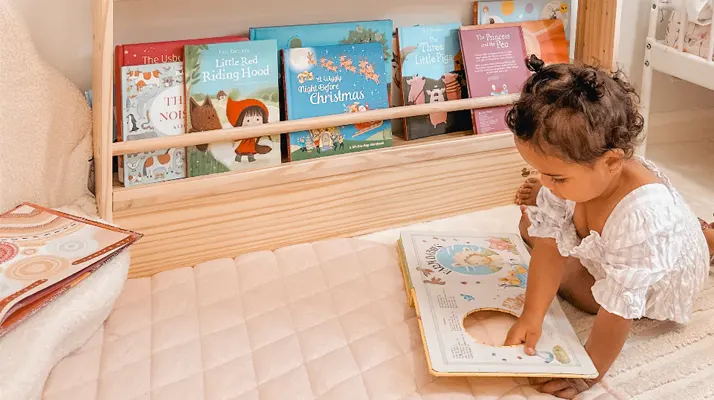
Creative expression area
Toddlers love experimenting with colors and textures. Provide easels, washable paints, crayons, and sensory bins filled with safe materials like rice or water beads. Keep supplies organized in low, open bins so children can access them independently.
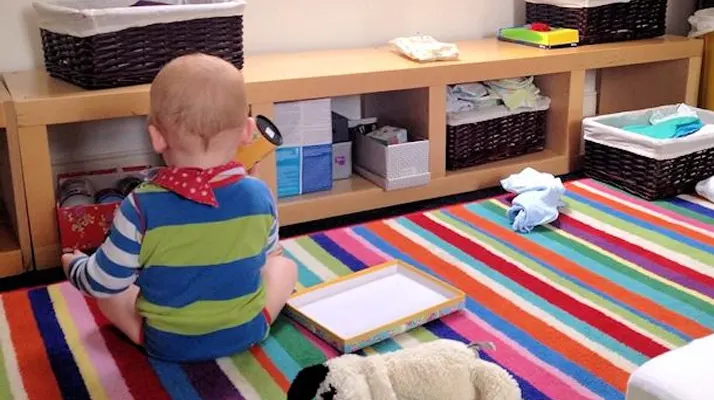
Safety and supervision
Arrange furniture to maintain clear sightlines and avoid creating hidden corners. Anchor shelves and secure play equipment, and use only non-toxic, easy-to-clean materials. This way, caregivers can monitor children easily, even when several activities are happening at once.
With these daycare room setup ideas for toddlers, the classroom becomes a space that channels their boundless energy into safe, structured activities—nurturing both independence and social learning.
Preschoolers’ Room Setup Ideas
As preschoolers begin to develop a deeper understanding of the world around them, their daycare room should foster a sense of independence, creativity, and problem-solving. This age group thrives in environments where they can engage in both structured and unstructured activities, building on the skills they’ve developed as toddlers. Thoughtful daycare room setup ideas help create a space where preschoolers can explore, collaborate, and continue developing essential cognitive and social skills.
Interactive Learning Stations
Set up interactive stations where preschoolers can experiment with learning materials like building blocks, science kits, or dramatic play costumes. These stations should be easily accessible and encourage collaboration and creativity. For instance, a small kitchen area for pretend play fosters social interaction, while a science corner with magnifying glasses and nature items sparks curiosity.
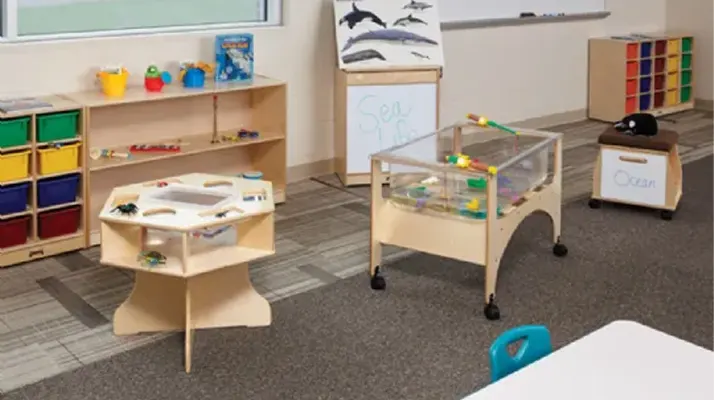
Clear Visual Cues and Routines
Preschoolers benefit from consistent daily routines. Use visual schedules with pictures and words to help them transition smoothly between activities. Make these schedules interactive, so children can mark off completed activities, reinforcing their sense of accomplishment.
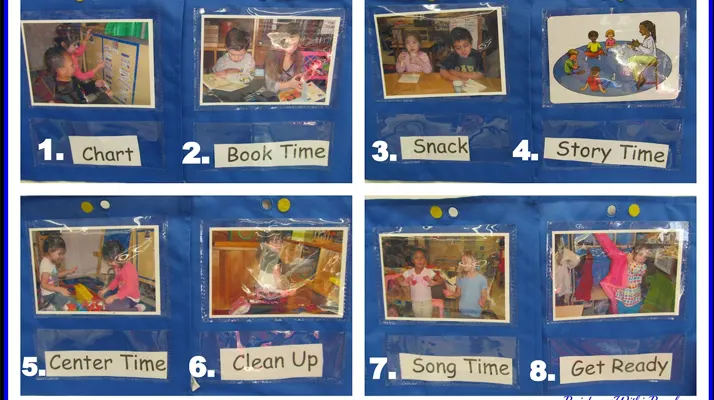
Durable, Play-Friendly Flooring
Preschoolers are active and enjoy moving around. Use flooring that supports both play and learning—from soft rugs for reading time to durable mats for physical activities. This ensures safety while providing a comfortable environment for all types of play.
By combining learning-focused zones, independence-building furniture, and ample opportunities for creativity, the daycare room setup for preschoolers becomes a space where children can grow, explore, and prepare for the next step in their educational journey. Thoughtful daycare setup ideas create an environment where preschoolers can thrive, develop essential skills, and become more independent as they prepare for school.
Home Daycare Room Setup Ideas
Setting up a daycare in your home comes with its own unique set of challenges and advantages. Home daycares offer a cozy, familiar environment that can make children feel more at ease. However, the space often needs to be optimized for both care and learning while ensuring safety and functionality. Here’s how you can create a safe, welcoming, and well-organized daycare in your home.
Maximize Use of Available Space
In a home daycare, space may be limited compared to larger daycare centers. It’s essential to maximize the available space while keeping it organized and functional. Think about dividing the room into different areas based on activity. Use low partitions, bookcases, or rugs to define spaces for play, rest, learning, and eating. Creating distinct zones for each activity not only helps keep things organized but also gives children a clear idea of what to expect in each area.
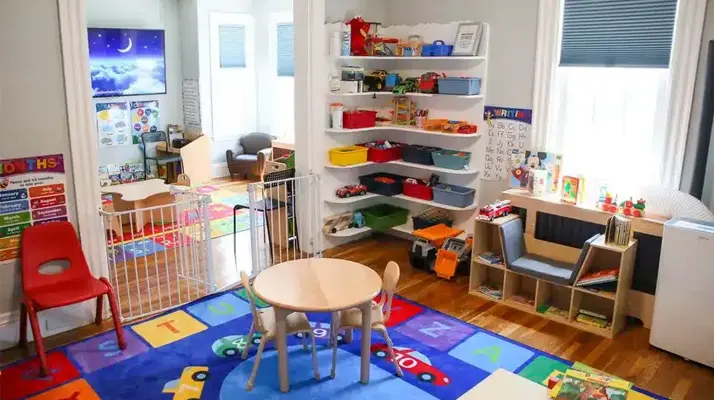
Create a Comfortable, Safe Play Area
One of the most important aspects of any daycare is a safe play area. In a home daycare, this area should be childproofed and equipped with soft flooring to cushion any falls. Depending on the space available, you can add small play structures, soft climbing toys, or even a small ball pit for physical activity. Keep the play area free from sharp objects or any items that may pose a safety hazard.
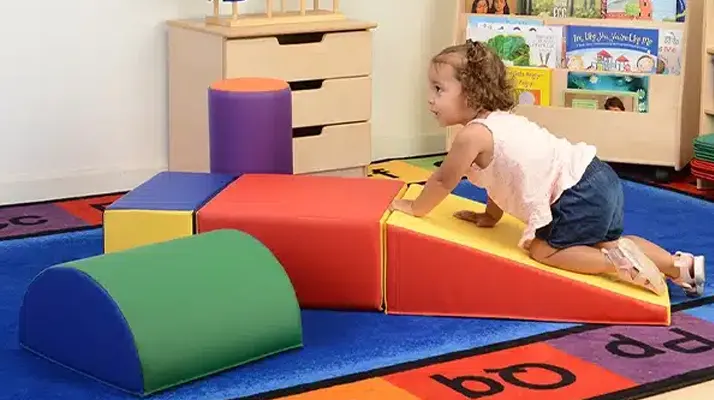
Incorporate Flexible Furniture
When space is limited, flexibility is key. Multi-purpose furniture is ideal for a home daycare. Consider pieces that can be easily moved or rearranged depending on the activity. For instance, a foldable table can be used for meals or activities, then tucked away when not needed. Stackable chairs or benches offer extra seating while saving space. Storage solutions such as baskets or under-bed bins help keep toys, books, and art supplies organized without taking up valuable space.
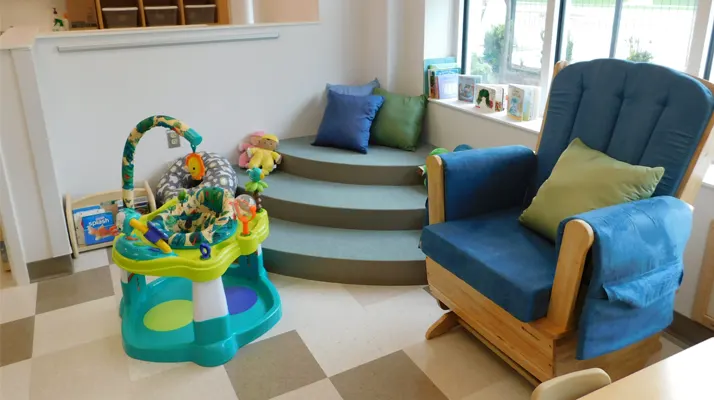
In a home daycare, the goal is to create a space that feels both nurturing and functional. By dividing the room into clearly defined areas, using flexible furniture, and focusing on safety and comfort, you can make your home daycare a place where children feel secure, loved, and ready to learn.
Daycare Room Setup Ideas: Safety
Creating a safe environment in your daycare room is non-negotiable. Safety should always be the number one priority when setting up a space for children, as it directly impacts their well-being. Every aspect of the room—from furniture and materials to the overall layout—should be designed with safety in mind.
Maintain Clear Sight Lines
One of the most fundamental safety principles is to ensure that caregivers have clear sight lines to every child in the room at all times. This means arranging furniture and play areas in a way that allows teachers to supervise all children without obstacles. When caregivers can see every child easily, they can respond quickly if a situation arises, reducing the risk of accidents or injuries.
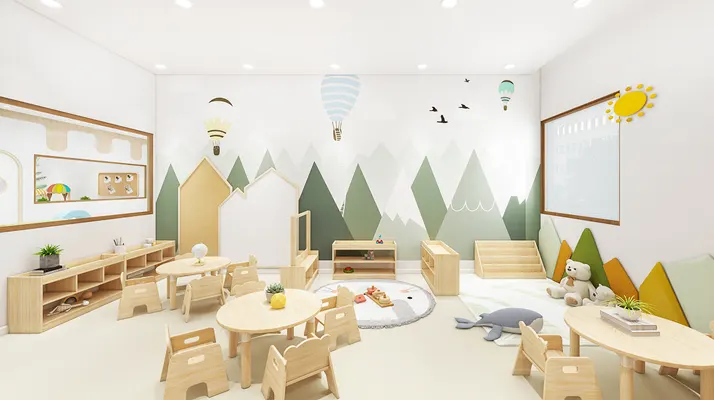
Anchor Furniture and Cover Outlets
Furniture should always be anchored to the walls to prevent tipping, especially in areas where children might be climbing or pulling. Tall furniture pieces, like bookshelves or cabinets, should be securely fixed to prevent accidents. In addition, cover all electrical outlets with outlet covers to avoid electrical shocks and other dangers to curious toddlers.
Use Non-Toxic Materials
From paints to furniture finishes, it’s crucial to choose non-toxic, child-safe materials. Children tend to explore their environment by putting things in their mouths, so using non-toxic paints, finishes, and materials ensures that any accidental contact won’t harm them. Be sure to choose age-appropriate, non-toxic materials for all toys and furniture.
Post Emergency Information Clearly
Every daycare room should have clear, visible evacuation routes and emergency contact information posted in easily accessible areas. In case of an emergency, such as a fire or natural disaster, knowing the escape routes and having immediate access to emergency numbers can make all the difference. This ensures that all staff and visitors are aware of safety procedures in the event of an emergency.
Keep Cleaning Supplies Secure
Cleaning supplies and chemicals should always be stored out of reach of children. Ideally, these supplies should be kept in childproof cabinets or locked storage areas to prevent accidental ingestion or exposure. Proper labeling and storing of chemicals and cleaning products ensure that your daycare is safe for both children and staff.
Install Guardrails and Door Locks
Guardrails can be securely installed along walls, particularly near areas like staircases, to keep children safe. Door locks are another critical safety feature, ensuring that only authorized adults have access to certain areas. Guardrails and locks can help prevent children from accessing potentially dangerous spaces, such as stairways, kitchens, or bathrooms, ensuring they remain safe as they play.
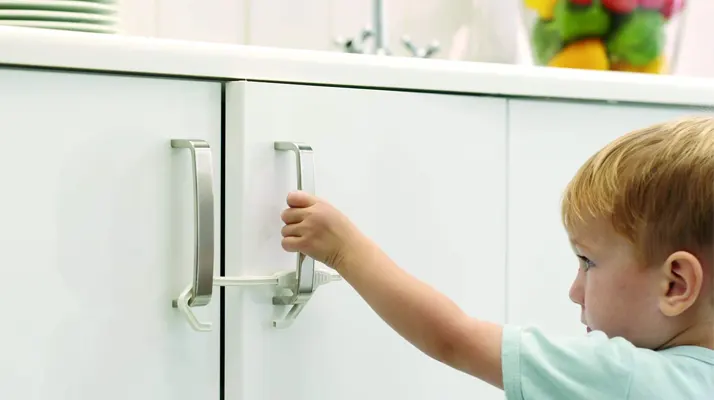
Use Baby Gates for Stairs and Play Areas
Baby gates are essential for keeping toddlers safe around stairs and doorways. Installing gates at the top and bottom of staircases prevents children from wandering into potentially dangerous areas unsupervised. You can also use gates to restrict access to rooms or areas that require adult supervision, such as cleaning supply rooms or outdoor play areas. This way, children can explore safely within a contained space.
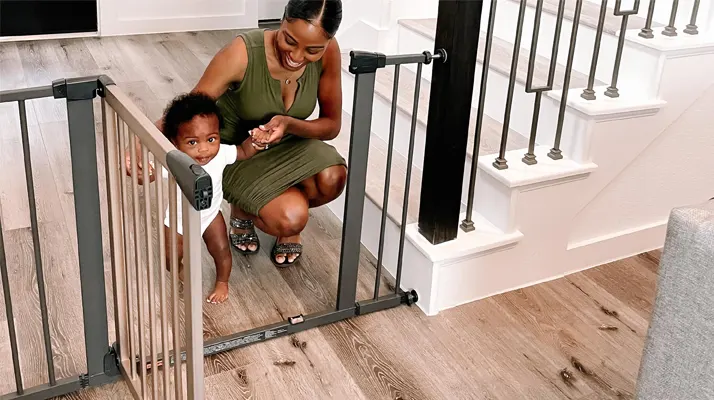
By integrating these safety features—from clear sightlines to baby gates, secure furniture, and non-toxic materials—you create an environment that promotes not only fun and learning but also peace of mind for caregivers and parents alike. Safety isn’t just a guideline; it’s the foundation of a daycare room setup that ensures children can grow, explore, and learn in the safest environment possible.
Daycare Room Setup Ideas: Emergency Supplies Area
When it comes to daycare, emergencies—whether they are minor or more serious—can happen at any time. Being prepared is crucial. Having a dedicated emergency supplies area within the daycare room helps ensure that caregivers can act quickly if needed, minimizing risks and promoting the safety of the children.
Create an Easily Accessible Emergency Supplies Area
The emergency supplies area should be located in a central location that’s easy for staff to access but out of reach of children. This designated space should be organized and stocked with essential items for a range of emergency situations. Keeping these supplies visible and accessible ensures that in the event of an emergency, caregivers won’t waste time searching for the necessary items.
First Aid Kit
Every daycare room should be equipped with a comprehensive first aid kit. This kit should include items like bandages, antiseptic wipes, gauze, tweezers, and adhesive tape, as well as a list of emergency contacts and instructions for dealing with common injuries. It’s important to check the first aid kit regularly to ensure that supplies are up to date and fully stocked.
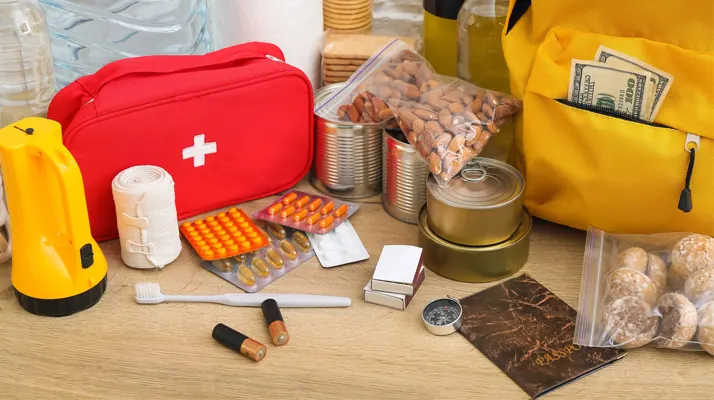
Fire Extinguisher
A fire extinguisher should be easily accessible in case of a fire emergency. Be sure to place it in a visible area, clearly marked and within reach of adults. Training staff on how to properly use a fire extinguisher is also essential. Regularly check the extinguisher’s functionality and make sure it meets local safety standards.

Emergency Contact Information
Keep emergency contact information posted clearly in the supplies area. This should include the phone numbers of emergency services, poison control, local hospitals, and parents or guardians. Additionally, a written evacuation plan should be posted near the supplies area, showing clear escape routes in case of a fire or other evacuation needs.
Medical Supplies for Special Needs
If any children in your care have special medical needs or allergies, you should keep relevant medical supplies in the emergency area. This could include an EpiPen for allergic reactions, inhalers for asthma, or a list of medications for children with specific medical conditions. Be sure to label these supplies clearly and ensure staff are trained in their use.
Safety Equipment for Evacuations
In case of a building evacuation, it’s helpful to have safety equipment like flashlights, whistles, and high-visibility vests in the emergency supplies area. Flashlights are essential during power outages, while whistles can be used to alert staff or children if evacuation is necessary. High-visibility vests make it easier to spot children during an evacuation, especially in crowded or chaotic situations.
Regularly Check and Update the Emergency Supplies
It’s important to regularly review and update the emergency supplies area to ensure that all items are in working order and ready for use. For example, check expiration dates on medical supplies, batteries in flashlights, and fire extinguishers to make sure they’re functional. A designated staff member should be responsible for maintaining and organizing this area, ensuring it remains fully stocked and easily accessible at all times.
Having a well-organized emergency supplies area is crucial in ensuring that your daycare is prepared for any unexpected situation. By keeping essential items on hand, training staff, and ensuring easy access, you create a safer environment where children can thrive without unnecessary risks.
FAQs About Daycare Room Setup Ideas
Setting up a daycare room can feel overwhelming, but breaking down the process into manageable steps makes it much easier. Below are some frequently asked questions to guide you through the setup of a daycare room and ensure it’s both safe and functional for children and caregivers.
1. What is the ideal layout for a daycare room?
The ideal layout for a daycare room should divide the space into clear zones for different activities—like play, learning, eating, and resting. Ensure that each zone is easily accessible and child-friendly. Use low shelves, rugs, or partitions to create boundaries between areas without overcrowding. The layout should also allow for clear sightlines, so caregivers can supervise all children at once.
2. How can I organize storage in a daycare room?
Efficient storage is key to keeping a daycare room organized and tidy. Use low shelves, cubbies, and labeled bins to store toys, books, and learning materials. This makes items easily accessible to children and encourages them to clean up after themselves. Multi-purpose furniture, such as a changing table with built-in storage or stackable bins, is also a great way to save space and keep the room neat.
3. What are the best materials for daycare room furniture?
When choosing furniture, look for materials that are durable, easy to clean, and non-toxic. Opt for solid wood or high-quality plastic for tables and chairs. Ensure all finishes are child-safe, and avoid furniture with sharp corners or easily detachable parts that could pose a choking hazard. Fabrics for cushions or rugs should be machine washable and stain-resistant, as daycare environments often face spills and accidents.
4. How can I create a calming atmosphere in the daycare room?
To create a calming atmosphere, use soft colors and natural light. Avoid harsh fluorescent lighting and opt for warm, soft lighting that mimics natural daylight. Incorporate soft furnishings like rugs, cushions, and beanbags to make the space feel cozy. You can also use soundproofing elements, such as carpets or acoustic panels, to reduce noise and create a quieter environment. Adding plants or nature-inspired decor can also contribute to a peaceful, calming atmosphere.
5. Should I use a theme in the classroom decor?
Using a theme in your daycare room decor can be a great way to create a fun and engaging environment for children. However, it’s important to keep the theme subtle and not overwhelming. A light, nature-inspired theme or a color scheme can work well without overstimulating young children. Choosing a calming, neutral palette as your base and adding playful accents (such as animal decals, soft mobiles, or themed storage bins) can balance aesthetics with functionality. For more on this, check out our article on creating a calming daycare room atmosphere.
6. What other supplies do I need when opening a daycare?
Opening a daycare requires more than just furniture and decor. Essential supplies include safety equipment, cleaning tools, and learning materials. These might range from first aid kits, fire extinguishers, and baby gates to toys, books, and sensory play items. Additionally, consider storing emergency supplies, such as medical kits and evacuation plans, in a designated space. For a complete list of must-have supplies, visit our article on daycare room safety and emergency preparedness.
7. Where can I find daycare room decor?
When it comes to decorating your daycare, there are plenty of options available. You can find affordable decor at home goods stores, craft shops, and online retailers like Amazon or Etsy. For more affordable daycare room decor, you can also explore second-hand stores for furniture, toys, and wall art. Additionally, DIY projects can be a great way to add personal touches to the space. Learn more about budget-friendly daycare decoration ideas in our article.
Conclusione
Designing the right daycare room setup takes more than arranging furniture—it’s about creating a nurturing environment where safety, comfort, and learning come together. From infant sleep zones to toddler activity centers and preschool learning stations, every detail influences how children grow, explore, and interact each day. By combining thoughtful layouts, age-appropriate furniture, and clear safety measures, you create a space that supports independence while offering peace of mind for caregivers and parents. Ultimately, the best daycare room setup ideas are those that balance functionality with warmth, ensuring children feel secure, inspired, and ready to thrive in every stage of their early development.

